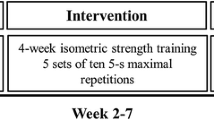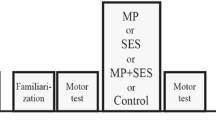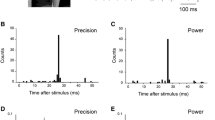Abstract
Although there were many reports relating to intermanual transfer of behavioral motor tasks in humans, it is still not well-known whether the transfer phenomenon between the trained and untrained hand is accompanied by corresponding changes in motor system. In the present study we applied transcranial magnetic stimulation to investigate the practice effects of unilateral fingertip precision grip on corticospinal excitability, regarding both the trained and untrained hand muscles. The results showed that after practice fingertip grip force became steady and safety margin dramatically decreased not only in the trained hand, but also in the untrained hand. Regarding MEP and background EMG (B.EMG) activities, the regression slope of MEP/B.EMG ratio in the first dorsal interosseous (FDI) muscle became significantly steeper after practice in both hands, but in the thenar (TH) muscle there were no clear modulations. These results indicated that through practice qualitative or functional changes of corticospinal systems related to the reorganization for a fingertip precision grip prominently reflect only on FDI muscle which plays a dominant role in the task. More importantly, such effects were simultaneously seen in the untrained hand correspondent to the trained hand, i.e., changes of input–output property in M1 occur not only in the trained hand, but also in the untrained hand. Based on the present results, we suggest that training-induced neural adaptations of the central nervous system may include improvement of its predicting fingertip grip force for self-lifting of the object in the untrained hand.




Similar content being viewed by others
References
Bloom JS, Hynd GW (2005) The role of the corpus callosum in interhemispheric transfer of information: excitation of inhibition? Neuropsychol Rev 15:59–71
Bonato C, Zanette G, Manganotti P, Tinazzi M, Bongiovanni G, Polo A, Fiaschi A (1996) ‘Direct’ and ‘crossed’ modulation of human motor cortex excitability following exercise. Neurosci Lett 216:97–100
Bonnard M, Gallea C, De Graaf JB, Pailhous J (2007) Corticospinal control of the thumb-index grip depends on precision of force control: a transcranial magnetic stimulation and functional magnetic resonance imagery study in humans. Eur J Neurosci 25:872–880
Boroojerdi B, Battaglia F, Muellbacher W, Cohen LG (2001) Mechanisms influencing stimulus-response properties of the human corticospinal system. Clin Neurophysiol 112:931–937
Calford MB, Tweedale R (1990) Interhemispheric transfer of plasticity in the cerebral cortex. Science 249:805–807
Caramia MD, Palmieri MG, Giacomini P, Iani C, Dally L, Silvestrini M (2000) Ipsilateral activation of the unaffected motor cortex in patients with hemiparetic stroke. Clin Neurophysiol 111:1990–1996
Carroll TJ, Riek S, Carson RG (2001) Reliability of the input–output properties of the cortico-spinal pathway obtained from transcranial magnetic and electrical stimulation. J Neurosci Methods 112:193–202
Chen R, Gerloff C, Hallett M, Cohen LG (1997) Involvement of the ipsilateral motor cortex in finger movements of different complexities. Ann Neurol 41:247–254
Classen J, Liepert J, Wise SP, Hallett M, Cohen LG (1998) Rapid plasticity of human cortical movement representation induced by practice. J Neurophysiol 79:1117–1123
Cole KJ, Rotella DL (2002) Old age impairs the use of arbitrary visual cues for predictive control of fingertip forces during grasp. Exp Brain Res 143:35–41
Cramer SC, Finklestein SP, Schaechter JD, Bush G, Rosen BR (1999) Activation of distinct motor cortex regions during ipsilateral and contralateral finger movements. J Neurophysiol 81:383–387
Criscimagna-Hemminger SE, Donchin O, Gazzaniga MS, Shadmehr R (2003) Learned dynamics of reaching movements generalize from dominant to nondominant arm. J Neurophysiol 89:168–176
Devanne H, Lavoie BA, Capaday C (1997) Input–output properties and gain changes in the human corticospinal pathway. Exp Brain Res 114:329–338
Gordon AM, Forssberg H, Iwasaki N (1994) Formation and lateralization of internal representations underlying motor commands during precision grip. Neuropsychol 32:555–568
Hammond GR, Vallence AM (2006) Asymmetrical facilitation of motor-evoked potentials following motor practice. Neuroreport 17:805–807
Hasegawa Y, Kasai T, Tsuji T, Yahagi S (2001) Further insight into the task-dependent excitability of motor evoked potentials in first dorsal interosseous muscle in humans. Exp Brain Res 140:387–396
Holm S (1979) A simple sequentially rejective multiple test procedure. Scand J Stat 6:65–70
Huang MX, Harrington DL, Paulson KM, Weisend MP, Lee RR (2004) Temporal dynamics of ipsilateral and contralateral motor activity during voluntary finger movement. Hum Brain Mapp 23:26–39
Imamizu H, Shimojo S (1995) The locus of visual-motor learning at the task or manipulator level: implication from intermanual transfer. J Exp Psychol Hum Percept Perf 21:719–733
Imamizu H, Miyauchi S, Tamada T, Sasaki Y, Takino R, Putz B, Yoshioka T, Kawato M (2000) Human cerebellar activity reflecting an acquired intenal model of a new tool. Nature 403:192–195
Johansson RS (1996) Sensory and memory information in the control of dexterous manipulation. In: Lacquaniti F, Viviani P (eds) Neural basis of motor behavior. Kluwer, Dordrecht, pp 205–260
Johansson RS, Westling G (1984) Roles of glabrous skin receptors and sensorimotor memory in automatic control of precision grip when lifting rougher or more slippery objects. Exp Brain Res 56:550–564
Johansson RS, Westling G (1988) Coordinated isometric muscle commands adequately and erroneously programmed for the weight during lifting task with precision grip. Exp Brain Res 71:59–71
Karni A, Meyer G, Rey-Hipolito C, Jezzard P, Adams MM, Turner R, Ungerleider LG (1998) The acquisition of skilled motor performance : fast and slow experience-driven changes in primary motor cortex. Proc Nat Acad Sci USA 95:861–868
Kasai T, Yahagi S (1999) Motor evoked potentials of the first dorsal interosseous muscle in step and ramp index finger abduction. Muscle Nerve 22:1419–1425
Kawashima R, Matsumura M, Sadato N, Naito E, Waki A, Nakamura S, Matsunami K, Fukuda H, Yonekura Y (1998) Regional cerebral blood flow changes in human brain related to ipsilateral and contralateral complex hand movements: a PET study. Eur J Neurosci 10:2254–2260
Kawato M (1999) Internal models for motor control and trajectory planning. Curr Opin Neurobiol 9:718–727
Kleim JA, Hogg TM, VandenBerg PM, Cooper NR, Brunean R, Remple M (2004) Cortical synaptogenesis and motor map reorganization occur during late, but not early phase of motor skill learning. J Neurosci 24:628–633
Kobayashi M, Hutchinson S, Schlaug G, Pascual-Leone A (2003) Ipsilateral motor cortex activation on functional magnetic resonance imaging during unilateral hand movements is related to interhemispheric interactions. Neuroimage 20:2259–2270
Koeneke S, Lutz K, Herwig U, Ziemann U, Jancke L (2006a) Extensive training of elementary finger tapping movements changes the pattern of motor cortex excitability. Exp Brain Res 174:199–209
Koeneke S, Lutz K, Esslen M, Jancke L (2006b) How finger tapping practice enhances efficiency of motor control. Neuroreport 17:1565–1569
Levin HS, Mattsm AJ, Levander M, Lindquist CEH, Simard JM, Guinto FC, Lilly MA, Eisemberg M (1993) Effects of transcallosal surgery in interhemispheric transfer of information. Surg Neurol 40:65–74
Liepert J, Terborg C, Weiller C (1999) Motor plasticity induced by synchronized thumb and foot movements. Exp Brain Res 125:435–439
Muellbacher W, Ziemann U, Boroojerdi B, Cohen L, Hallett M (2001) Role of the human motor cortex in rapid motor learning. Exp Brain Res 136:431–438
Muellbacher W, Ziemann U, Wissel J, Dang N, Kofler M, Facchini S, Boroojerdi B, Poewe W, Hallett M (2002) Early consolidation in human primary motor cortex. Nature 415:640–644
Ni Z, Takahashi M, Yamashita T, Liang N, Tanaka Y, Tsuji T, Yahagi S, Kasai T (2006a) Functional demanded excitability changes of human hand motor area. Exp Brain Res 170:141–148
Ni Z, Liang N, Takahashi M, Yamashita T, Yahagi S, Tanaka Y, Tsuji T, Kasai T (2006b) Motor strategies and excitability changes of human hand motor area are dependent on different voluntary drives. Eur J Neurosci 23:3399–3406
Oldfield R (1971) The assessment and analysis of handedness: the Edinburgh inventory. Neuropsychologia 9:97–113
Pascual-Leone A, Nguyet D, Cohen LG, Brasil-Neto JP, Cammarota A, Hallett M (1995) Modulation of muscle responses evoked by transcranial magnetic stimulation during the adquisition of new fine motor skills. J Neurophysiol 74:1037–1045
Poter R, Lemon R (1993) Corticospinal function and voluntary movement. Clarendon Press, Oxford, pp 90–121
Ridding MC, Rothwell JC (1997) Stimulus/response curves as a method of measuring motor cortical excitability in man. Electroenceph Clin Neurophysiol 105:340–344
Sadato N, Campbell G, Ibanez V, Deiber M, Hallett M (1996) Complexity affects regional cerebral blood flow change during sequential finger movements. J Neurosci 16:2691–2700
Sainburg RL, Wang J (2002) Interlimb transfer of visuomotor rotation: independence of direction and final position information. Exp Brain Res 145:437–447
Sathian K, Zangaladze A (1998) Perceptual learning in tactile hyperacuity: complete intermanual transfer but limited retention. Exp Brain Res 118:131–134
Schieber M (2001) Constraints on somatotopic organization in the primary motor cortex. J Neurophysiol 86:2125–2143
Schulze K, Luders E, Jancke L (2002) Intermanual transfer in a simple motor task. Cortex 38:805–815
Temprado JJ, Swinnen SP (2005) Dynamics of learning and transfer of muscular and spatial relative phase in bimanual coordination: evidence for abstract directional codes. Exp Brain Res 160:180–188
Thut G, Cook ND, Regard M, Leenders KL, Halsband U, Landis T (1996) Intermanual transfer of proximal and distal motor engrams in humans. Exp Brain Res 108:321–327
Thut G, Halsband U, Roelcke U, Nienhusmeier M, Missimer J, Maquire RP, Regard M, Landis T, Leenders KL (1997) Intermanual transfer of training: blood flow correlates in the human brain. Behav Brain Res 89:129–134
Thut G, Hauert C-A, Morand S, Seeck M, Landis T, Michel C (1999) Evidence for interhemispheric motor-level transfer in a simple reaction time task: an EEG study. Exp Brain Res 128:256–261
Valero-Cabre A, Oliveri M, Gangitano M, Pascual-Leone A (2001) Modulation of spinal cord excitability by subthreshold repetitive transcranial magnetic stimulation of the primary motor cortex in humans. Neuroreport 12:3845–3848
Verstynen T, Diedrichsen J, Albert N, Aparicio P, Ivry RB (2005) Ipsilateral motor cortex activity during unimanual hand movements relates to task complexity. J Neurophysiol 93:1209–1222
Wang J, Sainburg RL (2004) Interlimb transfer of novel inertial dynamics is asymmetrical. J Neurophysiol 92:349–360
Wolpert DM, Flanagan JR (2001) Motor prediction. Curr Opin Neurobiol 11:R729–R732
Wolpert DM, Ghaharamani Z (2000) Computational principles of movement neuroscience. Nat Neurosci 3:1212–1217
Yahagi S, Ni Z, Takahashi M, Takeda Y, Tsuji T, Kasai T (2003) Excitability changes of motor evoked potentials dependent on muscle properties and contraction modes. Motor Control 7:329–348
Yahagi S, Takeda Y, Ni Z, Takahashi M, Tsuji T, Komiyama T, Maruishi M, Muranaka H, Kasai T (2005) Modulations of input–output properties of corticospinal tract neurons by repetitive dynamic index finger abductions. Exp Brain Res 161:255–264
Zanette G, Bonato C, Polo A, Tinazze M, Mangono P, Fischi A (1995) Long-lasting depression of motor evoked potentials to transcranial magnetic stimulation following exercise. Exp Brain Res 107:80–89
Acknowledgments
This study was supported by Research Projects Grant-in-Aid for Scientific Research number 16500380 (T.K.) from the Ministry of Education, Culture, Sports, Science and Technology of Japan.
Author information
Authors and Affiliations
Corresponding author
Rights and permissions
About this article
Cite this article
Liang, N., Takahashi, M., Ni, Z. et al. Effects of intermanual transfer induced by repetitive precision grip on input–output properties of untrained contralateral limb muscles. Exp Brain Res 182, 459–467 (2007). https://doi.org/10.1007/s00221-007-1004-2
Received:
Accepted:
Published:
Issue Date:
DOI: https://doi.org/10.1007/s00221-007-1004-2




